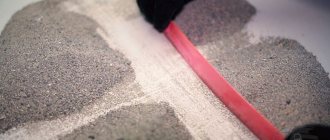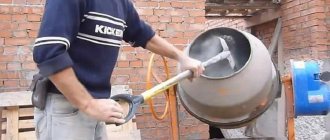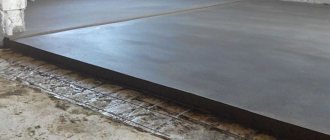In this short article I would like to talk about the basic properties and characteristics of concrete, its laying, setting time and other consumer qualities of this material, indispensable in construction. I would not like to grind water in a mortar and quote here encyclopedic data about concrete, which you could easily find in any article, which is copied from site to site in large quantities, and from a practical point of view is of little use. The terminology and text structure of such narratives can mislead even people who know the subject of the conversation. I once tried to glean some necessary information about concrete, but more often I came across either the cloth language of GOSTs or exercises. I, as a practicing builder, would like to talk about the most necessary things, and of course, I will try to do this in simple words: without the “conglomerate structure of stone-like materials in poured forms”
Quick section navigation:
- Concrete composition Main components and proportions. What is the concrete mixture made of?
- Strength of concrete Strength classes and grades. Samples, cubes, control.
- Workability of concrete Workability, cone slump, cast concrete.
- Frost resistance of concrete Frost resistance coefficient F.
- Water resistance of concrete Water resistance coefficient W.
- Hardening, hardening of concrete Setting times, winter concreting.
Proportions of concrete of different grades
The main classification of concrete is based on strength: average (M) and guaranteed (B). The first in digital equivalent ranges from 50 to 1000, the second - from 3 to 40. For example, the dry residue M250 can withstand a load of 250 kg/sq.m. cm (a monolith cube is taken as a test sample).
The classic formula for concrete looks like this in buckets:
- 1 – water;
- 2 – cement;
- 6 – sand;
- 10 – crushed stone.
However, the ratios may actually differ significantly depending on the nature of the raw material base.
The table shows the basic recipes. They will help with the issue of how to calculate the grade of concrete based on the components, depending on the type of binder (M400 or M500) and the declared characteristics of the working composition.
| Concrete (M) | Proportions of concrete per 10 kg of M400 cement | Concrete proportions per 10 kg of M500 cement |
| 100 | 10*46*70 | 10*58*81 |
| 200 | 10*28*48 | 10*35*56 |
| 250 | 10*21*39 | 10*26*45 |
| 300 | 10*19*37 | 10*24*43 |
| 400 | 10*12*27 | 10*16*32 |
| 450 | 10*11*25 | 10*14*29 |
| 500 | 10*10*22 | 10*12*25 |
The table shows that for a mortar with grade strength M300 you need to take 10 kg of M400 cement and 19 kg of sand, 37 kg of crushed stone. A solution with similar characteristics can be prepared from 10 kg of M500 cement, 24 kg of fine and 43 kg of coarse filler.
The proportion of water for concrete can range from 50 to 100% according to the volume of cement binder. For example, for M100 concrete, M500 binder is not used, but with M400, 1.03 parts are added to one cement. To obtain a solution of M300, pour in 0.53 (with M400) or 0.61 (with M500) parts of the volume of clinker powder.
What are the requirements for cements?
In the production of concrete, as a rule, three types of Portland cement with grades M400 and M500 are used: slag, aluminous or pozzolanic. The basic selection criterion here is the rate of formation of the hardened mass. Accordingly, the first one calculates at 12, the second at 10, and the third at 8 o’clock.
The current regulations regarding the characteristics of the binder component are GOST 31108-2003, SNiP 2.03.11-85 and TR-166-04. Here are some criteria:
- grinding 350-380 kg/sq. m with a permissible error of 10%;
- the thickness of the mixture is determined by the water content of 25-27%;
- The hardening process of the solution takes 2-5 hours.
The main requirements boil down to the terms of the guaranteed quality of the raw materials. For foundation and load-bearing structures, only fresh powder, just coming off the packaging conveyor, is used. The reason for this is the rapid decline in the performance of the clinker binder. In a month it’s 10%, in six months it’s already 30-35%. It is equally important to follow the rules for storing binder powder. These should be: sealed packaging, low humidity, wooden flooring, positive temperature.
Any deviations will lead to an accelerated decline in quality and the formation of cement stone. Such material will only be suitable for screeding a floor or casting a walkway with reinforced fabric or paving slabs.
Cement and water
Water and cement are the main components of concrete, which perform the main function: they bind all the components of the mixture into a single integral structure. One of the main tasks in concrete production is to achieve the correct water-cement ratio. Moreover, we are talking not just about the quantity of these components, but about taking into account such characteristics as the humidity of the crushed stone and sand used, the degree of their moisture absorption and other similar ones.
During the process of hydration (contact with water), cement can set and harden, resulting in the formation of cement stone. Many consumers encounter this phenomenon in everyday life, when, for example, they open a bag of cement that has been lying for a long time in damp conditions. It would seem that the stone is already self-sufficient, why, in this case, introduce other components into the mixture? The fact is that cement stone is prone to deformation. Its volumetric shrinkage can reach up to 2 mm/m. Despite the low indicator, shrinkage processes lead to internal stresses and the formation of microcracks, which are not visible, but negatively affect the strength and service life of cement stone. Such deformations can be reduced by introducing fillers into the composition of the prepared mixture.
What can be used as a placeholder
Only sand purified from natural impurities is added to the concrete mixture. River pulp is considered the best raw material, since quarry pulp is not naturally washed. A small clay content is acceptable, which gives the solution plasticity.
The coarse fraction filler is selected based on the required grade strength. This also applies to determining the ratios of components in concrete. For example, in combination with M500 cement, granite chips are added to the mixture. With M350 binder, gravel or crushed stone may be present.
Dimensions and specifications
Construction sand ready for mixing concrete has a round shape and almost identical dimensions. Grain fractions can be from 1.5 to 5 mm. The content of residual natural impurities and clay for the construction of critical structures is allowed within 5%.
For a specific brand of concrete, a sand mass is used, in which the difference in grain sizes should not exceed 1-2 mm.
Large aggregate should have broken edges. Rounded (pebble-like) shapes provide weak bonds between the components of the concrete mixture. There are three standard shapes in size: 3-10, 10-20 and 20-40 mm. Fine-grained filler can be added in a volume of up to 30% of the total.
If the formation of a concrete structure involves the presence of a reinforced frame, then the size of large grains should not exceed ⅓ of the minimum distance between individual rods. For a thin-layer blind area, they focus on its thickness and consider the same ⅓.
Workability, mobility, cone settlement.
All these terms basically mean the same thing. The designation in the invoices and passports of the concrete mixture is in the form of the letter P with a coefficient from 1 to 5 (example: P-3) or as follows: cone settlement is 10-15 cm. For practical use, it is important to know the following: For standard monolithic work, mobility concrete P- 2 - P-3. When pouring densely reinforced structures, narrow formworks, columns and other similar narrow cavities that are difficult to fill with concrete, it is advisable to use concrete with mobility n-4 and higher (cone draft 16-21 cm). Such a concrete mixture may be called poured concrete. (in the era of developed socialism, cast concrete was considered to be concrete with a cone draft of 12 cm - slightly more than n-2) These types of concrete mixtures tolerate laying in formwork well, without the use of a vibrator. A similar mobility of concrete should be chosen if a concrete pump is used to lay the concrete mixture
There is also such a thing as concrete hardness. Indicated by the letters Zh1-Zh4. Basically, when they talk about hard concrete, they mean lean concrete, used mainly in road construction. It is characterized by a reduced content of water and cement. I won’t write about super-hard types. It is unlikely that you will need it.
To make pouring easier and in the absence of vibrators on site, foremen and builders often increase the mobility by diluting the concrete in a concrete mixer with water, which is absolutely not worth doing! Because the water-cement ratio is one of the key proportions on which the final strength of concrete directly depends. Moreover, even a slight dilution of the mixture with water can significantly reduce the strength by one or two grades. Concrete of the design grade m300, as a result of dilution with water, can easily show m100 m200.
An increase in the mobility of the concrete mixture to indicators P4, P5, and a cone slump of more than 16 cm is achieved exclusively through the use of plasticizer additives at the plant. This is the only way to obtain cast concrete intended for laying in formwork with a dense frame of reinforcement, or for monolithic work using a concrete pump. By diluting the concrete mixture with water, you will certainly deteriorate its quality.
Application of additives
Let's look at what else the concrete mixture consists of. Various types of additives are added to the working concrete solution to adjust certain technical characteristics of the dry residue. The production and use of such materials is regulated by the current GOST 24211-2008. If metal reinforcement of structures is assumed, then GOST 31384-2008 is considered.
The main characteristics of the dry residue include not only the grade strength of concrete. The manufacturer also indicates frost resistance (F) and water absorption (W) in the accompanying documentation. Each of the three indicators can be influenced using functional additives.
Antifreeze additives
According to the technology, the formation of dry residue and strength development should take place under positive temperatures (from 10 to 25 degrees Celsius). At low rates, moisture crystallizes, which negatively affects the combination of components. If construction is carried out in winter, then the solution is made with special additives. They do not affect the quality of concrete and allow construction to be carried out in winter at temperatures from -30 degrees Celsius.
Antifreeze additives additionally help speed up the drying process of concrete. In winter, without them it would take more than 2 months.
The advantages include the naturalness of the process of gaining strength. There is no need to insulate the formwork or heat the structures at sub-zero temperatures. However, it is worth noting the risk of salt stains, the content of toxic substances, and strict requirements for proportions in the concrete composition.
Water repellents
Often structures are cast from concrete, which to one degree or another come into contact with moisture during operation. Cement is characterized by low water absorption, but the porous structure does not completely exclude the penetration of moisture into the body of the foundation, plinth or block wall.
When external waterproofing is not enough, water repellents are added to the solution. They are able to fill micropores and help increase the density of the dry residue. The truth here is that the situation with the thermal conductivity of the slab is worsening.
Strengthening additives
A reinforcing frame or mesh copes well with this task. However, concrete structures are less than 5 cm thick, which precludes laying a rod core. Here, fibers and liquid additives are used to enhance resistance to bending and compression.
Technically, hardeners are divided into three groups: weak, medium and strong. They also have a positive effect on the resistance of concrete to frost and reduce vapor permeability.
Frost resistance coefficient of concrete.
It is designated by the letter F with a number from 25 to 1000 and indicates the number of freezing-thawing cycles during which concrete retains its original strength characteristics (with acceptable deviations). What practical value does this parameter have for you? Well, in short, then: freeze-thaw cycles are transitions of a moisture-saturated concrete structure from a wet state to a frozen state and back.
What does this mean? Let's take a standard picture: moistening concrete structures using the example of capillary suction of moisture from the ground by the foundation of a house. Water, melting snow, wet soil, etc., fills the micropores of concrete according to a principle similar to the wick in a kerosene stove. Concrete here acts as an absorbent sponge. Then this water freezes in micropores, and when frozen, it expands, tearing apart everything that interferes with it. This is where changes in the structure of concrete occur: microcracks, etc. Moreover, next time, the water, having filled these microcracks and frozen, will tear them apart even more.
Of course, everything is not as scary as I described here, because foundations, as a rule, are protected by waterproofing, blind areas, and water repellents. Moistening does not occur so intensely, not over the entire thickness of the concrete, etc. But I would like you to more or less understand the nature of the process.
At concrete plants and concrete mixing units of various plants producing reinforced concrete products, tests of control samples are carried out in critical modes. The concrete cube is literally soaked in water (or a special solution) with full moisture saturation, and frozen at once to -18. And so on - with intermediate measurements, until the critical point is reached, namely, the loss of the design strength. The number of such water-ice cycles is the F coefficient. Foundations on moisture-saturated soils, bridge supports standing in water, and other hydraulic structures partially operate in this mode.
To increase frost resistance, concrete plants use various additives in concrete, for example air-entraining additives, etc. But frost resistance, increased by air-curing additives (exceeding the norm for this brand of concrete) reduces its strength. Found there, then lost. The best results in increasing frost resistance can be achieved by using hydrophobic or prestressing cement in mixing concrete. All main cycles occur in autumn and spring, when temperature changes occur every day from plus to minus and back. In conventional construction, the average frost resistance is F100-F200.
The next parameter of concrete that I would like to talk about is inextricably linked with frost resistance.
Crushed stone
It is best to choose the grade (strength) of crushed stone that is twice as high as the calculated grade of concrete. This is due to the fact that the design (28-day) grade of concrete is always much lower than its actual strength, which will appear within six months to a year. But the strength of crushed stone does not change over time, so they are leveled. This is done just in case, without necessarily agreeing with the design safety margin requirements. Excerpt from GOST 26633-91
There are three main types of crushed stone:
— Limestone (average strength 500-600). Limestone is most often used for the production of concrete grades m-100-m-300 due to its relatively low frost resistance, but some of its types (up to 800) are suitable for more durable concrete - up to m-350.
— Gravel is the most common filler due to the set of all the necessary characteristics for the production of most concrete mixtures. The main types of gravel (strength 800-1000) can be used to produce concrete grades up to m-450 (but not higher than m-400). It is recommended for private construction - due to its relative cheapness and strength sufficient for individual construction.
— Granite is the most durable of the listed fillers (m up to 1400). It has low water absorption and increased frost resistance. For example, only granite crushed stone is allowed for road construction.
In addition, there are some points associated with crushed stone that need to be taken into account: flakiness, percentage of weak rock grains and others.
Types of compounds
By purpose
The proportions of the concrete mixture are not constant: depending on what will be used as a binder and filler, as well as under what conditions the structure will be used, they may change. Below we will look at the classification of concrete according to a number of parameters.
Depending on the purpose, the compositions are divided into the following groups:
- Conventional solutions . They are used for forming building blocks, as well as for pouring monolithic structures. In most cases, they do not contain additional components except for modifiers that improve the natural properties of the material.
- Cellular materials . The concrete mixture for such a solution usually includes a pore-forming composition, which, when reacting with the components, releases gas. This gas in the form of small bubbles spreads throughout the poured concrete, ensuring an increase in its performance.
Porous materials of sufficient density can also act as load-bearing structures
Note! This group of materials often includes solutions with heat-insulating fillers, such as polystyrene concrete, expanded clay concrete, and wood concrete. Depending on the density, these composites can be used both for the construction of load-bearing structures with low thermal conductivity, and for insulating already constructed walls.
- Hydraulic concrete . They are characterized by minimal water permeability and do not deteriorate for a long time upon contact with water. They are usually used for lining dams, bridge trusses, etc., but can also be used in everyday life - for example, for constructing wells.
- Special compounds . Designed for use in extreme conditions. Includes components that can withstand operating loads for a long time. There are fire-resistant (cement-concrete mixture contains alumina, slag, broken fireclay bricks), acid-resistant, anti-radiation materials, etc.
- Separately, it is worth highlighting auxiliary solutions, which include, for example, a starting mixture for a concrete pump . This composition is prepared in almost the same way as construction cement, but we add much more water (about 150 liters per 2 bags of cement). Liquid “concrete milk” wets pipelines and prevents the formation of plugs.
Without starting mixture, it is almost impossible to start such a system.
- Finally, a separate group consists of repair compounds . These include fluid mixtures (used to restore horizontal surfaces) and thixotropic materials with low shrinkage (used to eliminate defects on vertical walls). The main advantage of these products is effective adhesion to already polymerized concrete.
By main substance
Regardless of where the composition will be used, it must be made on the basis of a binder - a substance that ensures the transformation of the mixture into a monolith.
According to this parameter, the following categories of materials are distinguished:
- Composition based on a cement binder. The simplest concrete mixture according to GOST is made on the basis of Portland cement of varying strengths. Pozzolanic cement and Portland slag cement are also used for construction. This variety is the most common, and therefore below we will focus mainly on its characteristics.
Note! This category also includes repair compositions with non-shrinking cement, as well as refractory mixtures with a high alumina content.
- Gypsum mortar is also included in the group of concretes. This material is used for finishing ceilings and constructing partitions. The combination of gypsum with pozzolanic cement provides a high level of water resistance, which is why such mixtures are used in the renovation of bathrooms.
- Slag-alkaline solution. It is produced by the action of alkalis on finely ground slag. It is used in pouring foundations, producing building blocks, and erecting monolithic structures. Reactions taking place in solution make it possible to effectively bind even low-quality aggregates with a high content of clay and silt fractions.
- Polymer-cement complexes. Typically they contain Portland cement mixed with latex, polyurethane or epoxy resin. After polymerization, a film is formed on the surface of the material, closing the pores and preventing moisture from penetrating into the thickness of the material. Polymer cement is used for finishing floors, walls, garden paths, etc. The key disadvantage is the fairly high price.
Fillers
The parameters that characterize the concrete mixture also include the composition of the filler. Without this component, we will only have a cement-sand mortar at our disposal, which is more expensive and inferior in strength to full-fledged concrete.
As a filler we use:
- Limestone . It is cheap and easy to process, but has relatively low strength (up to 600). In principle, it can be used for the preparation of foundation compositions, however, low frost resistance limits the geography of use.
Note! Crushed limestone is usually used as a filler for cement no stronger than M300.
- Gravel (strength 800-1000). Available, relatively cheap, and has quite satisfactory performance characteristics. It is the gravel backfill that is most often used when preparing concrete mortar with your own hands.
Photos of different gravel fractions
- Granite . It costs more than gravel, but it is superior in strength and heat resistance. It practically does not deform even with sudden temperature changes, so the instructions recommend using it as a filler for structures with high strength requirements.
A separate group consists of fillers that provide increased thermal insulation:
- Expanded clay concrete mixture can be used both for monolithic pouring and in the form of building blocks. Expanded clay is characterized by sufficient strength and moisture resistance, and retains heat well.
- Polystyrene granules are introduced into the solution to improve its thermal performance. The more polystyrene, the lower the density of the material, which is why the instructions recommend using some types of such concrete only as cladding.
To reduce thermal conductivity, polystyrene granules can be added to the solution
- Sawdust and wood chips are used to produce the so-called wood concrete. If the manufacturing technology is followed, wood filler almost completely loses its sensitivity to moisture. At the same time, the thermal conductivity of the masonry decreases many times.
The process of preparing concrete mixture
If we convert the weight fractions indicated at the beginning of the article into volume fractions, it turns out that the following amount of material is required to prepare 1 m3 of concrete:
- cement with an average bulk density of 1300 kg/m3 - 0.25 m3;
- water - 0.18 m3;
- crushed stone with a density of 1350 kg/m3 - 0.9 m3;
- sand with a density of 1400 kg/m3 - 0.43 m3.
When adding up the indicators, the total volume turns out to be 1.76 m3. How such a volume fits into 1 m3 of concrete can be understood by considering a simple example. If you take an ordinary liter jar and fill it with crushed stone, then between the grains there will be a lot of intergranular voids, i.e. free space. This void can be filled, shaking and stirring, with two glasses of sand, a glass of cement and a glass of water. As a result, everything fits in and a dense consistency is obtained. After this, the concrete quickly begins to harden. Vibrating and stirring helps to give the prepared mixture plasticity again.
The finished concrete mixture has a certain alphanumeric index and is described with a mandatory indication of the brand (M) and class (B) for strength, workability (P), water resistance (W) and frost resistance (F).
Types of pigments and their properties
Pigments are used to change the color of concrete structures. In industrial production, the following are used for these purposes:
- carbon black;
- titanium dioxide;
- chromium oxide;
- umber.
All pigments act on the concrete mixture in the same way: they absorb part of the light waves, and reflect waves of other wavelengths. Such pigment additives have increased resistance to ultraviolet radiation, do not fade in the sun, are not washed off by rain and are resistant to aggressive chemical environments.
Technology for producing high-quality concrete
Even an experienced builder is not able to accurately measure all proportions to obtain factory-strength concrete. An additional difficulty will arise in determining the required volume. The loaded components will shrink after mixing. Sand and cement will take up space between the filler stones. The same goes for water. With a real load of 2 buckets of cement, 5 buckets of sand and 9 buckets of crushed concrete, less than 16 buckets will come out. Sometimes the figure is reduced to 50%.
So, in reality, you need to get M-300 concrete using M500 cement. We perform the following actions:
From the table above we select the component ratio 10:22:37. Divide all numbers by 10 to reduce. We get a ratio of 1:2:4. Based on the volume of cement, we calculate the required volume of water. One bucket of cement weighs approximately 12.5 kg, which means you need to take 12.5/2 = 6.25 kg of water. Let's round this number to 7kg. Since 1 liter of water weighs 1 kg, therefore, 7 liters of water are needed.
- Pour 8 liters of water into the concrete mixer tank. During the initial mixing, we take this volume with a small margin. The concrete mixer is dry, 1 liter of liquid will be used to moisten the tank.
- Since the solution needs to be plastic, add 0.6 liters of plasticizer to the water. It is better to measure using a measuring cup. You can use the measurements on the container, but the portions will be approximate.
- After water, load 4 buckets of crushed stone, give about 2 minutes of time to moisten all the stones. We fill in 2 buckets of sand and 1 bucket of M-500 cement. The order of filling the components is different for each builder. The proposed option is considered the best. If sand and cement are loaded in front of the crushed stone, then the loose components, after getting wet, will stick to the walls of the concrete mixer drum.
- It is advisable to use individual buckets for solid components and water. Cement in paper bags weighing 25 kg is convenient to pour out of the packaging immediately. When divided in half, you get exactly 2 buckets. We lay the bag flat on the ground, place a rail across it, and cut the packaging with a knife. By lifting both ends of the slats, the halves separate. All that remains is to use a knife, on the other hand, to cut the bag.
Divide the bag of cement into 2 equal parts.
- After loading all the components, turn on the concrete mixer. Minimum kneading time 5 minutes. We unload the finished solution into a trough or wheelbarrow.
- After unloading, we immediately load the second filling. Now we pour a smaller proportion of water - 7 liters, as originally calculated. The concrete mixer tank is wet, it will not draw liquid onto itself. If the solution turns out to be dry, it is better to add a little water while mixing.
We make exactly as many batches as needed for concreting. At the end of the work, we immediately wash out the concrete mixer tank, otherwise it will be difficult to deal with hardened concrete later.
Concrete composition: components, their sizes and characteristics
Most concrete consists of three main components:
- The binder is most often cement, sometimes lime.
- Fillers - sand, crushed stone, pebbles.
- Water.
Different quantities of just three components give a wide range of qualities and characteristics. To impart special properties, various additives and additives are also used, which greatly expands the scope of use of this material.
All these brands of concrete are made from the same components, but in different proportions
The main characteristic of concrete is its strength or the load that it can withstand for a long time without losing its strength characteristics. This parameter is the key when choosing the grade of concrete for the foundation. Water permeability and frost resistance may also be important. But these are the characteristics of the “ripened” material, which depend on the recipe. And when kneading, you may be interested in such a characteristic as workability. It reflects the degree of concrete fluidity and depends on the amount of water in the composition. You can increase fluidity without adding water using additives, as well as increase frost resistance and water-repellent properties.
The strength of concrete depends on how accurately the recipe was followed, on the quality of the ingredients and on how thoroughly everything was mixed. Only with a homogeneous composition and high-quality components can design characteristics be achieved. Read more about what components can be used and the requirements for them at the end of the article.
Mixture base
Cement is the main binding component. It is also marked for strength. The correct choice of building material brand is based on the following parameters:
- Purpose and features of the structure.
- Production technology.
- The need to withstand aggressive environments and substances.
- Temperature changes.
- Waterproof.
The building material does not tolerate long-term storage, since after a month its original properties begin to be lost.
We must not forget about the terms and conditions of storage. The properties of the mixture change after a month of storage, and six months will deteriorate them by 30%. For storage, you need to choose a dry, ventilated room. Otherwise, the material will absorb moisture from the air, form lumps and its use will become impossible. There are different types of building powder available, but Portland cement is more commonly used. The chemical composition of concrete is determined by the components of cement dust:
- silicon dioxide - 20-70%;
- calcium oxides - 50-60%;
- oxides of aluminum, iron, magnesium.
Kneading and laying
The plasticity of concrete is determined by its position on a horizontal shovel. If it moves, then it is too plastic; when it moves with a slight tilt, the degree of plasticity is low (medium), and if it does not slide off the inclined shovel, it is not plastic. The middle option is suitable for homestead construction. When mixing is done manually, it is imperative to follow the sequence of introducing the components: sand, cement, after mixing - water, crushed stone. Thorough mixing ensures complete coverage of each aggregate stone with the mixture, eliminating wall and bottom compactions. Manual concrete laying is slow. Delay is fraught with delamination.











